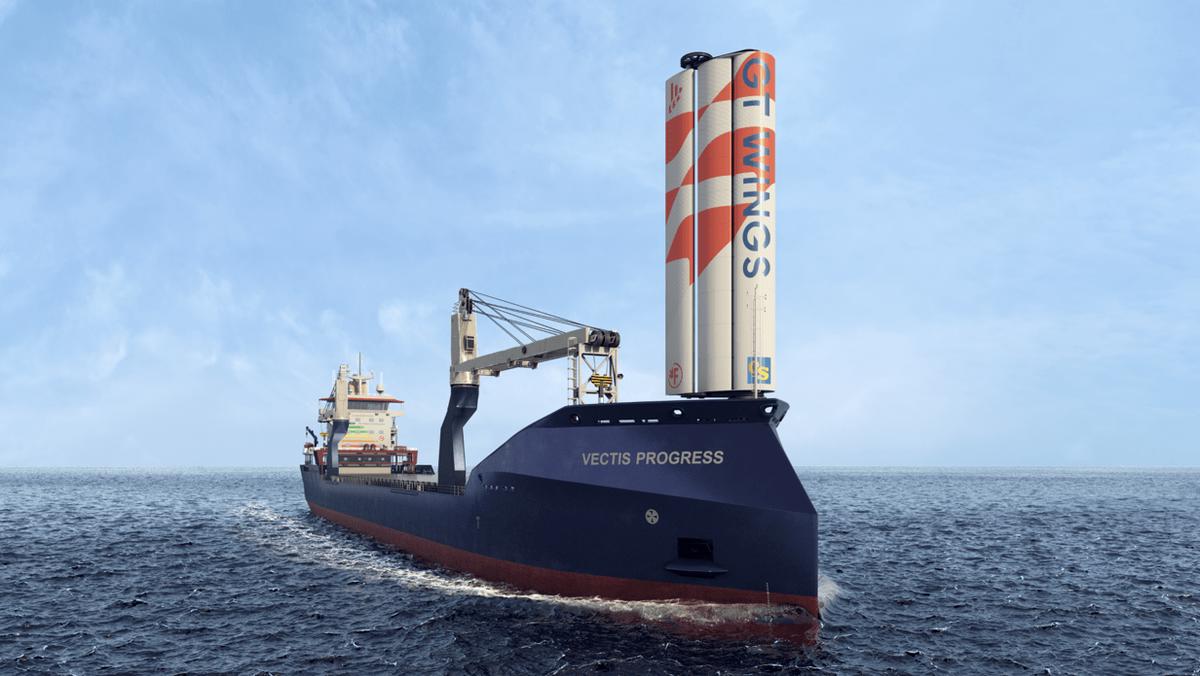The Week in Alt Fuels: Sails, savings and compliance
A surge in wind-assisted propulsion projects in recent weeks highlights the industry’s push to cut fuel use and boost efficiency. The ball is now in regulators’ court to decide whether wind savings will earn compliance credit.
 IMAGE: Wind-propulsion system installed on a cargo vessel. GT Wings
IMAGE: Wind-propulsion system installed on a cargo vessel. GT Wings
Singapore-based BW Epic Kosan has partnered with Spanish technology firm Bound4blue to install a suction sail on its LPG carrier Helena Kosan. The 24-metre unit is scheduled for installation in 2026, marking a mainstream operator’s move into wind propulsion trials.
Japan’s Mitsui O.S.K. Lines (MOL) has secured approval from Lloyd’s Register for two LNG carriers that will each be equipped with four 49-metre hard sails. MOL has also outlined broader plans to install wind systems on nine vessels, including six bulk carriers that will receive Wind Challenger rigid sails.
The company expects fuel savings of 7–16% per vessel depending on route and weather.
In addition, MOL plans to equip three bulk carriers with rotor sails, estimated to save 15–28% when three are installed together. Two ventilated foil systems will also be fitted on one vessel and are expected to reduce fuel consumption by about 2%.
Kawasaki Kisen Kaisha (K Line) confirmed that its kite-based propulsion concept has successfully completed land-based testing. The company reported positive results on tensile strength and performance using a 300-square-metre kite, marking the first phase of development.
UK-based BAR Technologies has fitted its rigid sail system on a new tanker for Union Maritime. The vessel has been designed to incorporate solid wing sails to harness wind power alongside conventional propulsion.
These projects underline the variety of technologies now being deployed - suction sails, rigid sails, rotor sails, kites and foils - as shipowners seek real-world data on how much fuel and on-board emissions each design can save.
Wind propulsion can reduce fuel consumption and improve ships’ energy efficiency, which in turn can enhance their Carbon Intensity Indicator (CII) rating. The economics are also straightforward: less fuel burned means lower bunkering costs.
But under current EU practice, wind energy is treated purely as an efficiency measure rather than a credited zero-carbon input.
A ship burning less fuel still reports the same emissions intensity per megajoule (MJ), even if its overall intensity has dropped. The gains are therefore financial rather than regulatory, since the ship’s actual CO2-equivalent/MJ score remains unchanged.
The International Windship Association (IWSA) has argued that this underestimates the role of wind.
In a past submission to the IMO, it has said that energy generated from wind propulsion should be fully accounted for in greenhouse gas fuel intensity (GFI) calculations. GFI measures emissions in grams of CO2-eq/MJ of energy, and IWSA proposes that onboard wind power should be recognised as renewable energy replacing part of the fossil fuel requirement.
To achieve this, IWSA recommends establishing an “energy equivalent of an internal combustion engine” to quantify how much propulsion energy a rotor sail or suction sail provides. This approach would ensure that wind is measured fairly alongside other energy sources, it stresses.
If regulators adopt such direct crediting, wind systems could become a powerful tool alongside lower-emission fuels. A ship’s reported GFI would fall directly, not just through reduced fuel use, creating potential for compliance credits rather than only cost savings.
In practice, this could allow global shipowners to meet near-term targets by combining wind-assisted propulsion with fuels such as biofuels or liquefied biomethane, while giving producers more time to scale up output of the fuels with zero-emission potential that are needed in the longer term.
For now, installations are rising and momentum is clear. The next move lies with regulators on whether wind propulsion will be given the formal credit needed to make its impact fully count towards meeting tightening decarbonisation targets.
In other news this week, Polish renewable energy firm Hynfra plans to build a 100,000 mt/year green ammonia plant at the Port de l’Amitié in Nouakchott, Mauritania by 2030. The facility will draw power from the Somelec wind farm, with additional solar and wind capacity along with on-site green hydrogen production. Hynfra has not yet confirmed whether the product will be used for bunkering.
Classification society Lloyd’s Register (LR) and South Korea’s HD Hyundai Mipo have partnered to develop a 22,000 cbm LNG bunkering vessel. The project focuses on delivering a safe, regulation-compliant and commercially viable design to meet the growing demand for LNG bunkering.
Germany’s Port of Kiel now offers shore power at all terminals, with capacity for three cruise ships and four ferries to connect at once. That’s five years ahead of the EU’s Alternative Fuel Infrastructure Regulation (AFIR) 2030 deadline for Trans-European Transport Network (TEN-T) ports.
Japanese firms Kawasaki Heavy Industries and Mitsui Engineering & Shipbuilding have secured approval from ClassNK for their jointly developed ammonia-capable LPG/ammonia carrier design. The certification confirms the vessel’s feasibility from both regulatory and safety standpoints.
By Konica Bhatt
Please get in touch with comments or additional info to news@engine.online





